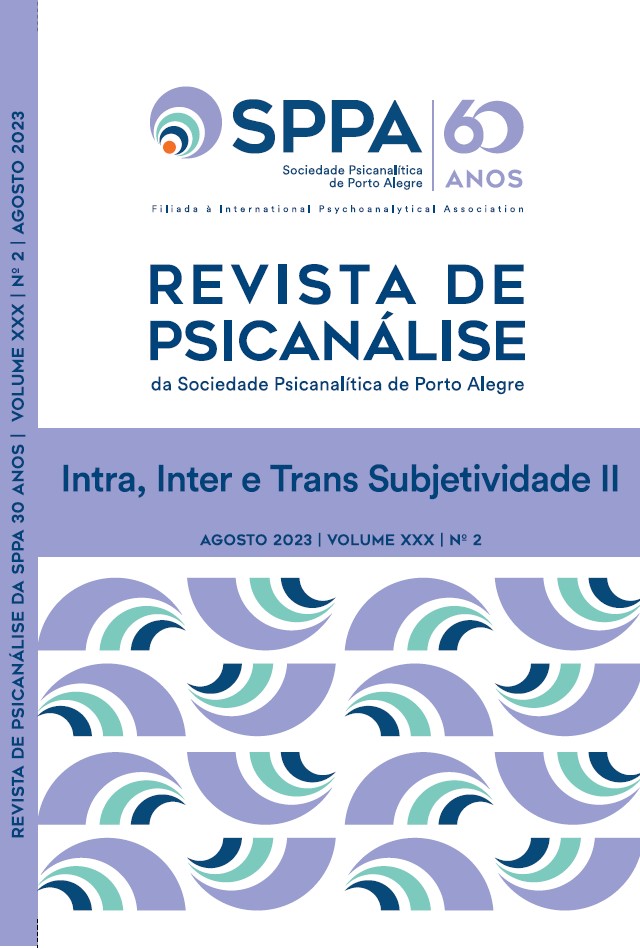Fragmentação de identidade: muitos para tentar ser um
Palavras-chave:
Dissociação, Dissociação de identidade, Memória, Trauma, Vivências traumáticasResumo
A autora discute a inter-relação psicanalítica entre vivências traumáticas e fenômenos dissociativos. Compreende que a constituição dinâmica entre várias partes do self fica impedida significativamente em consequência de experiências traumáticas. Nessa perspectiva, a partir de sua clínica e do referencial de outros autores que trabalham com transtornos dissociativos, inclusive de identidade, terá como principais objetivos: 1º - compreender os fenômenos dissociativos, 2º - entender como se constrói uma mente fragmentada a partir de vivências traumáticas e 3º - trazer algumas abordagens psicanalíticas que possam favorecer, nos pacientes e analistas, a maior integração entre seus estados de self.
Downloads
Referências
Alayarian, A. (2011). Trauma, torture and dissociation: a psychoanalytic view. London: Karnac Books.
Bohleber, W. (2008). Recordação, trauma e memória coletiva: a luta pela recordação em psicanálise. Revista de Psicanálise da Sociedade Psicanalítica de Porto Alegre, 15(1), 35-65.
Bollas, C. (1992). Sendo um personagem. Rio de Janeiro: Revinter, 1998.
Breuer, J. & Freud, S. (1976). Estudos sobre a histeria. In Freud, S. Edição standard brasileira das obras psicológicas completas de Sigmund Freud, (Vol. 2). Rio de Janeiro: Imago. (Trabalho original publicado em 1895)
Breuer, J. & Freud, S. (1976). Sobre o mecanismo psíquico dos fenômenos histéricos: comunicação preliminar In Freud, S. Edição standard das obras psicológicas completas de Sigmund Freud, (Vol. 2). Rio de Janeiro: Imago. (Trabalho original publicado em 1893)
Bromberg, P.M. (2009). Multiple self-states, the relational mind, and dissociation: a psychoanalytic perspective. In Del, P.F. & O’Neil, J.A. (Ed.). Dissociation and dissociative disorders, (pp. 639-645). London: Routledge.
Bromberg, P. M. (2011). The shadow of the tsunami and the growth of the relational mind. London: Routledge.
Bucci, W. (2001). Pathways of emotional communication. Psychoanalytic Inquiry, 21(1), 40-70.
Bucci, W. (2007). Dissociation from the perspective of multiple code theory: part I: psychological roots and implications for psychoanalytic treatment. Contemporary Psychoanalysis, 43(2), 165-184.
Chefetz, R. (2015). Intensive psychotherapy for persistente dissociative processes. New York: W. W. Norton & Company.
Cozolino, L. (2014). The neuroscience of human relationships: attachment and developing social brain, (2. ed). New York: W. W. Norton & Company.
Ferenczi, S. (1992). Confusão de língua entre os adultos e a criança. In Psicanálise IV. (pp. 97-106). São Paulo: Martins Fontes. (Trabalho original publicado em 1933)
Fonagy, P. & Sandler, J. (2018). Recovered memories of abuse: true or false? London: Routledge. (Trabalho original publicado em 1997)
Freud, S. (1994). A divisão do Ego no processo de defesa. In Freud, S. Edição standard brasileira das obras psicológicas completas de Sigmund Freud, (Vol. 23). Rio de Janeiro: Imago. (Trabalho original publicado em 1938)
Freud, S. (1994). Além do princípio do prazer. In Freud, S. Edição standard brasileira das obras psicológicas completas de Sigmund Freud, (Vol. 18). Rio de Janeiro: Imago. (Trabalho original publicado em 1920)
Freud, S. (1994). Fetichismo. In Freud, S. Edição standard brasileira das obras psicológicas completas de Sigmund Freud, (Vol. 21). Rio de Janeiro: Imago (Trabalho original publicado em 1927)
Freud, S. (1994a). Hereditariedade e a etiologia das neuroses. In Freud, S. Edição standard brasileira das obras psicológicas completas de Sigmund Freud I, (Vol. 3). Rio de Janeiro: Imago. (Trabalho original publicado em 1896)
Freud, S. (1994). Luto e melancolia. In Freud, S. Edição standard brasileira das obras psicológicas completas de Sigmund Freud, (Vol.14). Rio de Janeiro: Imago. (Trabalho original publicado em 1917)
Freud, S. (1994b). Novos comentários sobre as neuropsicoses de defesa. In Edição standard brasileira das obras psicológicas completas de Sigmund Freud, (Vol. 3). Rio de Janeiro: Imago. (Trabalho original publicado em 1896)
Freud, S. (1994). O Ego e o Id. In Freud, S. Edição standard brasileira das obras psicológicas completas de Sigmund Freud, (Vol. 19). Rio de Janeiro: Imago. (Trabalho original publicado em 1923)
Gabbard, G.O. (2014). Psiquiatria psicodinâmica, (5. Ed). Porto Alegre: Artmed.
Green, A. (2010). Histeria y estados limite: quiasmo. In El pensamento clínico, (pp. 77-106). Buenos Aires: Amorrortu. (Trabalho original publicado em 2002)
Green, A. & Urribarri, F. (2019). Do pensamento clínico ao paradigma contemporâneo: diálogos. São Paulo: Blucher. (Trabalho original publicado em 2013)
Howell, E. (2020). Trauma and dissociation informed psychotherapy: relational healing and the therapeutic connection. New York: W. W. Norton & Company.
Janet, P. (1889). L'automatisme Psychologique. Paris: Alcan.
Loewenstein, R.J (2018). Dissociation debates: everything you know is wrong. Dialogues Clin. Neurosci. Sep, 20(3), 229–242.
McWilliams, N. (2014). Diagnóstico psicanalítico. Porto Alegre: Artmed
Modell A. H. (1999). The dead mother syndrome and the reconstruction of trauma. In Kohon, G. (Ed.). The dead mother, (pp. 76-86). New York: Routledge.
Motta, M.G. (2006). Estresse em bebês de mães deprimidas. In Congresso Internacional de Neuropsicanálise, Pasedena, USA.
Motta, M.G. (2022). Vivências traumáticas e dissociação. Congresso da Febrapsi, 28, Rio de Janeiro.
Negro Junior et al. (1999). Dissociação e transtornos dissociativos: modelos teóricos Brazilian Journal of Psychiatry, 21(4). https://doi.org/10.1590/S1516-44461999000400014
Ogden, H.T. (2014). Leituras criativas. São Paulo: Escuta. (Original publicado em 2012)
Perry, B. D. (2001). The neurodevelopmental impact of violence in childhood. In Schetky, D., & Benedek, E.P. (Ed.). Textbook of child adolescent forensic psychiatry, (Vol. 18, pp. 221-238). Washington: American Psychiatryc Press. https://www.researchgate.net/publication/253039874_
Pessoa, F. (1932). Psicografia. http://multipessoa.net/labirinto/fernando-pessoa/1.
Porges, S. (2011). The polyvagal theory: neurophysiological foundations of emotions, attachment, communication, and self-regulation. New York: W. W. Norton & Company.
Putnam F. (1992). Discussion: are alter personalities fragments or figments? Psychoanalytic Inquiry, 12, 95-111.
Reik, T. (1925). Como se llega a ser psicologo. Buenos Aires: Horme, 1927.
Renn, P. (2012). The silente past and the invisible present. New York/London: Routledge.
Roussillon, R. (2000). Atualidade de Winnicott. TRIEB, 9, 55-71.
Roussillon, R. (2012a). A dor e o existir. CPRJ: Caderno Psicanalítico, 34(27), 107-116.
Roussillon R. (2012b). O desamparo e as tentativas de solução para o traumatismo primário. Revista de Psicanálise da Sociedade Psicanalítica de Porto Alegre, 19(2), 271-295.
Roussillon, R. (2013). A destrutividade e as formas complexas da “sobrevivência” do objeto. Revista da Sociedade Brasileira de Psicanálise de Porto Alegre, 14(2),553-572.
Roussillon, R. (2014). Trauma narcísico-identitário e sua transferência. Revista Brasileira de Psicanálise, 48(3), 187-206.
Roussillon R. (2015). Traumatismo primário, clivaje y lazos primários no simbólicos. Docta, 11.
Roussillon, R. (2016). A elaboração e seus modelos. Leitura principal, Congresso da IPA em Berlim, julho de 2007. Psicologia da USP, 27(2), 367-374.
Schore, A. (2009). Relational trauma and the developing right: an interface of psychoanalytic self-psychology and neuroscience. Self and systems: ann, 1159, 189-203.
Schore, A. (2011) Foreword. In Bromberg P.M. The shadow of the tsunami and the growth of the relational mind. London: Routledge.
Solms M. & Turbull O. (2002). The brain and the inner world: an introduction to neuroscience of subjective experience. New York: Other Press.
Spiegel, D. (2008). Coming apart: trauma and the fragmentation of the self. In Cerebrum. New York: Dana Press.
Stern, D.B. (2009). Partners in though: a clinical process theory of narrative. Psychoanalytic Quarterly, 78(3), 701-731
Van der Kolk, B.A. (2002). Trauma and memory. Psychiatry and Clinical Neurociences, 52(1), 52-64. https://doi.org/10.1046/j.1440-1819.1998.0520s5S97.x
Wilson, E.O. (1999). Consilience: the unity of knowledge. New York: Vintage.
Winnicott, D.W. (1971). The mirror-role of mother and family in the child’s development. In Playing and reality. Middlesex: Penguin.
Winnicott, D.W. (1990). A capacidade para estar só. In O ambiente e os processos de maturação: estudos sobre a teoria do desenvolvimento emocional, (3. ed.). Porto Alegre: Artes Médicas. (Trabalho original publicado em 1958)
Winnicott D.W. (2011). Fear of breakdown. In Caldwell, L. & Joyce, A. (Ed.) Reading Winnicott. Canada: Routledge, 2011. (Trabalho original publicado em 1963)
Winnicott D.W. (2011). Primitive emotional development. In Caldwell, L. & Joyce, A. (Ed.). Reading Winnicott. Canada: Routledge. (Trabalho original publicado em 1945)
Winnicott, D.W. (2011). The theory of parent-infant relationship In Caldwell, L. & Joyce, A. (Ed.). Reading Winnicott. Canada: Routledge. (Trabalho original publicado em 1960)
Downloads
Publicado
Como Citar
Edição
Seção
Licença

Este trabalho está licenciado sob uma licença Creative Commons Attribution-NonCommercial-NoDerivatives 4.0 International License.
Atribuo os direitos autorais que pertencem a mim, sobre o presente trabalho, à SPPA, que poderá utilizá-lo e publicá-lo pelos meios que julgar apropriados, inclusive na Internet ou em qualquer outro processamento de computador.
I attribute the copyrights that belong to me, on this work, to SPPA, which may use and publish it by the means it deems appropriate, including on the Internet or in any other computer processing.
Atribuyo los derechos de autor que me pertenecen, sobre este trabajo, a SPPA, que podrá utilizarlo y publicarlo por los medios que considere oportunos, incluso en Internet o en cualquier otro tratamiento informático.










